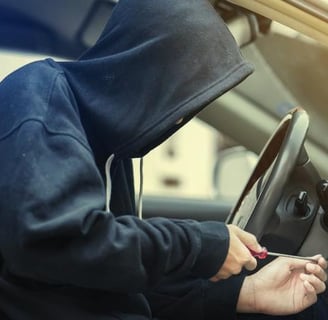Preventing Vehicle Theft: Comprehensive Tips and Insights
This blog provides a detailed guide on preventing vehicle theft, covering practical tips such as locking doors, using tracking systems, and parking in secure areas. It also explores how stolen vehicles are often used in other crimes and highlights the alarming trend of cars being stolen and shipped overseas, particularly through ports like Montreal. The blog emphasizes the role of organized crime in vehicle theft and offers insights into law enforcement efforts and technological advancements aimed at curbing this global issue.
9/10/20246 min read


Preventing Vehicle Theft: Comprehensive Tips and Insights
Vehicle theft is a persistent and growing problem in many parts of the world, including Canada, the U.S., and Europe. In fact, the latest reports reveal that car theft has reached alarming levels, with organized crime syndicates often being behind the increasing numbers. These stolen vehicles are not just a monetary loss for owners but are frequently used in other criminal activities, including smuggling, trafficking, and even violent crime. Moreover, there is an alarming trend of stolen vehicles being shipped overseas, particularly through Canadian ports like Montreal, where organized crime rings operate efficiently.
This blog post offers a comprehensive guide to protecting your vehicle from theft, understanding how stolen cars are used, and the growing trend of international smuggling. With prevention strategies, awareness, and diligence, you can significantly reduce your chances of falling victim to vehicle theft.
1. Understanding Why Vehicles Are Stolen
A. Joyriding and Temporary Transportation
Many thefts are crimes of opportunity where cars are stolen for temporary use, often by joyriders. These vehicles are usually recovered within a few days but often return damaged.
B. Selling Parts
Some thieves steal vehicles with the intention of stripping them for parts. This is particularly true for popular makes and models, as parts for these vehicles have higher demand.
C. Organized Crime and Smuggling
One of the most concerning aspects of vehicle theft today is its connection with organized crime. Vehicles are stolen and then exported overseas, with many shipped from ports like Montreal to regions in Africa, the Middle East, and Europe. These stolen cars are often resold in black markets, where tracking them becomes virtually impossible.
D. Vehicles Used in Other Crimes
Once stolen, vehicles can also be used in other criminal activities. Whether for drug trafficking, smuggling weapons, or even being used as getaway cars in burglaries, a stolen vehicle can quickly become part of a larger crime. Criminals favor using stolen cars because it provides them with anonymity, reducing the risk of detection while carrying out illegal activities.
2. Ways to Prevent Your Vehicle from Being Stolen
Preventing your vehicle from being stolen requires a combination of awareness, smart habits, and anti-theft measures. Below are detailed steps you can take to protect your vehicle:
A. Always Lock Your Doors and Windows
While this might seem obvious, many vehicles are stolen because owners forget to lock their doors or windows. Modern cars come with remote locking systems, but it's always good to double-check if your vehicle is securely locked. Thieves look for easy targets, and an unlocked car provides a perfect opportunity.
B. Remove or Hide Valuables
Leaving valuables in plain sight, such as laptops, bags, or even loose change, can entice thieves to break into your car. Even if your vehicle isn't stolen, a smashed window can be costly and frustrating. Always remove valuables or hide them from sight.
C. Use a Steering Wheel Lock
Steering wheel locks are a visible deterrent. While they aren't foolproof, they make it much more difficult for thieves to drive off with your car. Thieves often look for vehicles that can be stolen quickly, and a visible anti-theft device can discourage them.
D. Install a Vehicle Tracking System
A vehicle tracking system (GPS-based) can significantly increase the chances of recovering your vehicle if it’s stolen. Many insurance companies offer discounts for vehicles equipped with tracking devices, recognizing their effectiveness. In the event of a theft, authorities can track the car’s location in real-time, increasing the chances of recovery.
E. Park in Well-Lit Areas
Where you park your car can greatly influence the likelihood of it being stolen. Thieves typically avoid well-lit, busy areas where there’s a higher chance of being noticed. Parking in a garage or near security cameras is also a strong deterrent.
F. Don’t Leave Spare Keys in the Vehicle
Many people leave a spare key inside their vehicle, often hidden in obvious spots like the glove compartment or under the mat. Thieves know to check these locations, so it's best to avoid storing spare keys inside the vehicle.
G. Invest in an Alarm System
If your car doesn’t already have one, consider installing a high-quality alarm system. Modern alarms can do more than just sound when the vehicle is tampered with; some are equipped with features like motion detectors and real-time alerts sent to your phone.
H. Keyless Entry Theft Prevention
Keyless entry systems, while convenient, have opened the door to new methods of vehicle theft, such as "relay attacks." Thieves use devices to capture signals from key fobs inside homes, allowing them to unlock and start the car without the key. To prevent this:
- Store your key fob in a signal-blocking pouch (also known as a Faraday pouch) when not in use.
- Turn off the key fob’s wireless signal, if your vehicle has that option.
- Keep your key fob away from exterior doors or windows.
I. Use a Kill Switch
Installing a kill switch disrupts the flow of electricity to essential parts of the engine. Without knowledge of its location, the thief will be unable to start the car. It's a highly effective way of preventing vehicle theft, especially for high-target vehicles.
3. Understanding the Global Reach of Vehicle Theft
A. The Montreal Connection
Montreal has become a major hub for car theft, with thousands of stolen vehicles being shipped overseas each year. Criminal organizations target high-end vehicles, which are often stolen to order, meaning thieves have specific makes and models they’re looking to steal.
From Montreal, these stolen cars are loaded onto shipping containers and sent to destinations such as Africa and the Middle East, where they are resold at a premium price. Once these vehicles leave Canadian waters, recovering them becomes incredibly challenging due to jurisdictional issues and the difficulty in tracking vehicles across borders.
B. The Smuggling Process
After being stolen, cars are usually taken to a “chop shop,” where they are given fake identification numbers and fraudulent paperwork. From there, they are loaded into shipping containers. Organized crime syndicates work with corrupt officials at ports to bypass security checks, allowing the cars to be shipped abroad. Once overseas, these vehicles can be sold for two to three times their market value in North America, making the theft highly lucrative.
C. The International Market for Stolen Vehicles
The demand for stolen vehicles in international markets is fueled by weak law enforcement in certain regions, a lack of standardized global vehicle registration systems, and a high demand for vehicles in developing countries. Countries in West Africa, Eastern Europe, and the Middle East have been identified as top destinations for stolen vehicles.
4. The Consequences of Vehicle Theft Beyond Financial Loss
A. Vehicle Theft and Crime
Stolen vehicles are often used to commit other crimes. This includes transporting drugs, firearms, or illegal goods. In some cases, the cars are used to conduct violent crimes like armed robberies or drive-by shootings. Once the vehicle has served its purpose, it's often abandoned or burned to destroy evidence.
The use of stolen cars in crimes makes it more difficult for law enforcement to trace the perpetrators. Moreover, when criminals use your car in such activities, it can lead to legal complications or insurance issues, as proving you weren’t involved may not always be straightforward.
B. Emotional Impact
Beyond the financial impact, the theft of a vehicle can be an emotional blow to owners. Cars are often tied to significant moments in life – family trips, commutes to work, or personal milestones. The loss can create stress, frustration, and a sense of violation that lasts long after the vehicle has been stolen.
5. How Law Enforcement is Combating Vehicle Theft
A. Technological Advances
Law enforcement agencies are increasingly relying on technology to combat vehicle theft. License plate recognition (LPR) systems are being deployed in high-traffic areas to detect stolen vehicles. These systems can scan thousands of plates per minute and instantly alert officers if a stolen vehicle is detected.
In addition, efforts are being made to work with international law enforcement agencies to track and recover vehicles that have been shipped overseas. Interpol, for example, maintains a global stolen vehicle database to help countries track stolen cars across borders.
B. Public Awareness Campaigns
Public awareness is key in preventing vehicle theft. Many local police departments regularly issue tips on how to secure your vehicle and encourage community members to report suspicious activities. The more educated and vigilant the public becomes, the harder it will be for thieves to operate.
C. Auto Industry Collaboration
The automotive industry is also taking steps to reduce vehicle theft. Manufacturers are investing in advanced anti-theft systems, and some are working closely with law enforcement to ensure that vehicles are difficult to steal and easy to track.
6. Conclusion: Stay Vigilant and Informed
Vehicle theft is not just a financial inconvenience—it’s a serious issue that fuels organized crime, impacts public safety, and contributes to a global black market. By taking the appropriate preventive measures, staying aware of trends in vehicle theft, and understanding how stolen cars are used, you can help protect your vehicle and contribute to broader efforts to combat this issue.
From securing your vehicle with basic steps like locking doors to investing in advanced anti-theft systems, you have the power to deter thieves. While law enforcement continues to crack down on car theft rings and smuggling operations, personal vigilance remains an essential part of the solution.
Keep in mind that vehicle theft can happen anywhere, at any time. By taking preventive measures, you’re not only protecting your vehicle but also playing a role in disrupting larger criminal activities. Stay informed, stay cautious, and take action today to keep your vehicle—and your community—safe.


